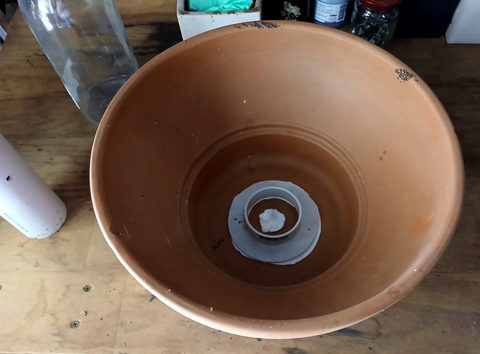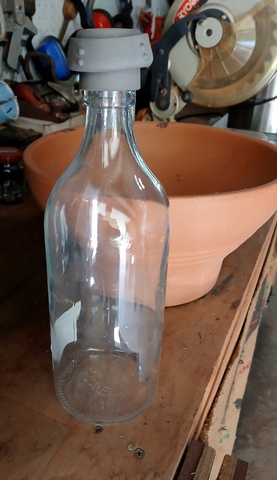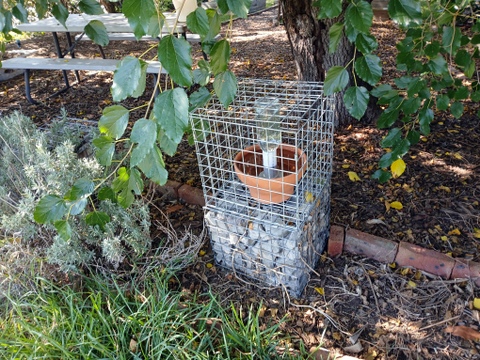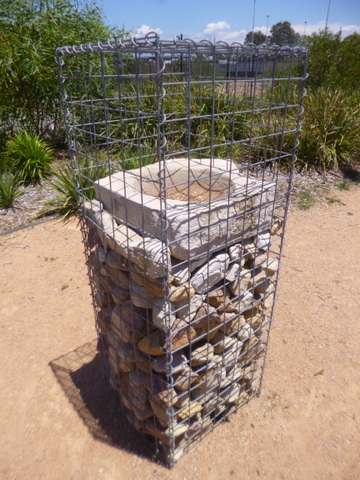Small Bird Waterer (ie a waterer for birds that are small, not a bird waterer that is diminutive)
While walking around St Clair, I see lots of small birds such as willy wagtails, swallows and sparrows, but I don’t see them often around our place, and never at our bird waterer. On thinking about it, I considered that maybe because the larger birds tend to take it over. Was there anything I could do about that?
Back in 2017, Russ Grayson took me for a tour around the Randwick Community Garden and Sustainability Hub (photos from the tour are available here). It was a fascinating place and one of things I noted (and photographed) was a bird waterer, placed inside a gabion. The idea was that the larger birds would be excluded and prevented from taking over the water source. Smaller birds, however, could get inside the wire cage formed by the gabion, accessing the water and finding refuge from the larger birds.
Maybe I could do the same thing!
I was able to get hold of a gabion of the same size as the ones that I used to fill with concrete waste (For more info check here) and then got hold of similar sort of materials that I used to make by original bird waterer (check out that article here). There were a couple of minor differences: The terracotta bowl had a slightly different profile, the original being 135mm high and 320mm in diameter, and the new one is 150mm high and 300mm in diameter. Also, I didn’t have a spare cordial bottle to use as a reservoir and had to buy a bottle, the best seemed to be one from Ikea (Korken), from which I removed the wire frame and stopper.
Making the Bath
The first task was to block the drain hole, easily done by some white silicon. All I did was place a plastic bag under the pot then put in the silicon until the hole was filled to the brim. I then left it for 24 hours so the silicon could cure. I also used some more silicon to attach a 50mm floor flange upside down to the bottom of the pot in the centre. I cut the length of pipe to put into the affixed flange so that the lip of the bottle was about 12mm below the rim of the dish, so that when the water level dropped below that point water would flow from the upturned bottle into the birdbath, refilling it. To facilitate this water flow I drilled a series of 3mm holes around the pipe just below the level of the bottle opening. I used a bit more silicon to fix the tube into the flange.



As with the previous bird waterer, I placed a 25mm cuff onto the end of the glass bottle by pushing it onto the neck of the bottle and folding it over (with some effort) on itself twice, giving it a very snug fit, with no movement of the bottle at all. With the waterer now complete, it was time to put the gabion together.
Assembling the Gabion
As previously mentioned, the instructions on how to put the gabions together by the manufacturer was pretty sparse and amounted to – ‘put ‘em together; put ‘em in place; fill ‘em with rocks’. The sides are essentially composed of 2.5mm wire configured into 50mm x 50mm squares, and the sides are held together with these weird looking clips (see pic). I found that a pair of long nose pliers and a pair of combination pliers allow the clip to be held in place by one, and the tabs bent over to secure it by the other. Roles of the pliers vary depending on access. I put two or three clips on each side and the bottom. I have no intention of securing the top as I will need to lift it up so I can remove and refill the bottle reservoir.



I am hoping that the 50mm x 50mm mesh will allow the smaller birds through without difficulty, after some reading around I was not able to find any recommendation for mesh sizes, so we will have to see. If I need to, I can cut out some of the wire and increase the size of the holes, but I will just have to see!
Putting Everything in Place
After a bit of a look around I decided that a good place to try out the new bird waterer was on top of one of the existing gabions I had put together earlier. It was protected and shaded by the mulberry tree, but was still easily accessible by the birds from the north across open lawns. I picked the one closest to the house because it was the most level.

I set it all up, filled it full of water, closed the top and we are ready to go! As luck would have it, the height of the bird waterer is exactly 400mm, the height of the gabion, so the top of the gabion rests nicely on the upturned bottom of the bottle.
I guess it is pretty experimental at the moment, and I will have to see how it goes in the long run.



